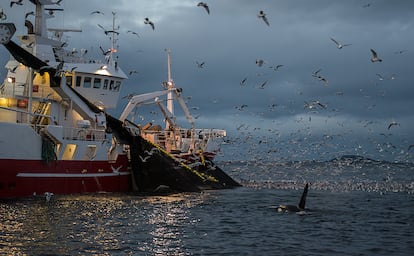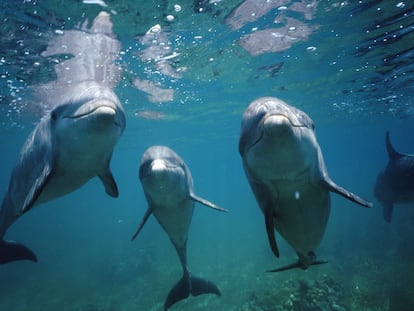Dolphins are no longer helping out fishers
The few mutually beneficial relationships between humans and animals are disappearing, according to experts

During the golden age of whaling, there was a whaling station in Twofold Bay in south-east Australia. But the fishermen did not have to go far to hunt for the cetaceans; a pod of orcas did the job for them: while some of the orcas rounded up the whale — right whales, the occasional humpback and even blue whales — pushing them towards the shore, others would swim towards the land, jumping and splashing in the water to attract the attention of the whalers, who only had to get into their boats to harpoon the animal. Once caught, they would leave the whale in the water for a day, giving the orcas time to eat the part of the prey that interested them: the tongue. The next morning, they would retrieve the animal to boil it and turn it into oil. In 1930, when oil had long since been replaced by petroleum and the whaling station was abandoned, the last of Twofold’s orcas died, and with it one of the rare relationships between humans and animals not based on killing the other.
This story of collaboration and mutual benefit is told by Flinders University professor Danielle Clode in her book Killers In Eden. And it is not the only example of humans and animals working together. While the vast majority of interactions between humans and animals have traditionally been conflictual — if not exploitative, with the former terminating the latter — there are a few cases of mutualism. Dolphins helping fishers in Brazil, birds guiding people to a beehive full of honey in Tanzania or crows locating beetle larvae highly sought after by the Kanaks of New Caledonia.
In the past, there were a few more examples, such as the rare case of wolves and Native Americans collaborating to hunt bison and even mammoths. As well as the Twofold orcas, there was a similar pod in the Kamchatka Peninsula (far east of Russia). The end of the whaling industry put a stop to this collaboration. Now the very few remaining cases in which humans and animals help each other out are also at risk of disappearing.

For as long as locals can remember, fishers in Laguna, in southeastern Brazil, have been waiting for dolphins. In almost all seas, the two do not get along. Fishers blame dolphins for depleting their catch and breaking their nets. While dolphins might argue that humans are taking away their food. But in this Brazilian bay, bottlenose dolphins wait for schools of mullet to pass. When they do, they organize to push them towards the coast. Meanwhile, following a strategy similar to that of the Twofold’s killer whales, some of the dolphins approach the beach to attract the attention of humans with splashes and specific sounds that they only make on these occasions. It is then that the fishers cast their nets. But what do the animals gain by helping them?
Mauricio Cantor is a researcher of animal behavior at the Marine Mammal Institute at Oregon State University. He has been studying dolphins in Laguna for years and explains what they get out of it: “They benefit from easier access to schools of fish. Schools are a great defense against predators, and their fast, coordinated movements make it difficult for a dolphin to catch a fish.” But by herding them and driving them towards fishers, “dolphins make it easier for them to access the fish, and, by casting nets, fishers end up disturbing that defense,” he explains. The nets break up the school, making it easier for dolphins to catch their share. The fishermen profit greatly from this collaboration. A 2023 study by Cantor estimated that the chances of fishers catching something increased 17-fold on days when they were called by the dolphins. And, when they were successful, catches quadrupled.
But with each passing year, dolphins are coming less frequently to warn their old allies. For reasons that remain to be clarified, this collaboration is declining. “Our data and predictive models suggest that, with the declining availability of fish and the decreasing number of dolphins and expert fishers, cooperative fishing could disappear,” says Cantor. The key seems to be that there is less and less fish. Among the causes of this decline, the researcher highlights the overexploitation of industrial fisheries “that can capture most of the migratory fish banks before they reach the estuaries and bays where artisanal fishers with nets interact with dolphins.”
Large-scale fishing also appears to be largely to blame for the fall in collaboration between dolphins and humans in Mauritania. Bruno Díaz, chief biologist and director of the Bottlenose Dolphin Research Institute BDRI, recalls that until the mid-1980s, “the fishers went to the shore, called the dolphins, they came closer, making noises, the fishermen cast their net and everyone won.”
Díaz says there are multiple reasons why this practice is in decline: competition from industrial fishing, pollution, nautical traffic and “above all the abandonment of traditional fishing techniques; before the nets were made of cotton, the dolphin could get entangled, but it could break the net and get out.” Now, nets are almost indestructible — as seen by the large amount of sea plastic they account for. “Dolphins have enormous behavioral plasticity, just like higher primates and humans. In other words, they are animals that have to change when faced with a change in the environment or conditions, it is the only option to survive.”
Honey birds
There are very few cases of mutualism between humans and terrestrial species. The most studied is that of the greater honeyguide, a bird related to the woodpeckers, which is native to the savanna of sub-Saharan Africa. Traditional hunter-gatherer groups — such as the Hadza in Tanzania or the Yao of Mozambique — rely on the bird to find honey. The bird can be summoned with a series of calls and whistles. If there is one nearby, they wait for the bird to give the first clue, which is to perch on a tree and flutter while emitting very specific sounds. When the human approaches, the bird moves to the next tree, and if the person does not follow it, it returns to find them. From tree to tree, it leads the human to a hive of honey bees. In this way, humans find honey, while the bird gets easier access to the wax and the larvae of the beehive.
Jessica van der Waal — a researcher at the FitzPatrick Institute for African Ornithology at the University of Cape Town — has been studying the greater honeyguide for years. In an article published in 2022, she warned that this very special interaction was much more widespread in the past. Currently, four different communities in Kenya, Tanzania and Mozambique have been recorded interacting with honey birds. However, Van der Waal explains by email that “research is being carried out in many more places, and it is being discovered that it occurs in many areas.”
Like the relationship between dolphins and fishers, the interaction is under threat for many reasons. The most immediate is that humans now have more alternatives for honey. What’s more, modernization — in addition to pressuring traditional hunter-gatherer groups and destroying bird habitat — is causing unexpected effects, For example, this symbiotic relationship has disappeared in a region of Cameroon as beekeeping has become a more popular business. As a result, honey birds were often leading honey seekers to their own hives or, worse, to those of other beekeepers.
Danielle Clode, the author of the book on the Twofold orcas, argues that modernization also makes humans less interested in collaborating with animals: “I think most examples of collaboration between humans and animals come from communities that already have a strong cultural connection to animals.” She points to the fact that most of the crew in the Australian bay were Aboriginal people who had a strong spiritual connection to the orcas: “They believed that when they died they would come back as orcas, so the orcas were literally their family, and they wouldn’t let the European whalers harm them.”
Sign up for our weekly newsletter to get more English-language news coverage from EL PAÍS USA Edition
Tu suscripción se está usando en otro dispositivo
¿Quieres añadir otro usuario a tu suscripción?
Si continúas leyendo en este dispositivo, no se podrá leer en el otro.
FlechaTu suscripción se está usando en otro dispositivo y solo puedes acceder a EL PAÍS desde un dispositivo a la vez.
Si quieres compartir tu cuenta, cambia tu suscripción a la modalidad Premium, así podrás añadir otro usuario. Cada uno accederá con su propia cuenta de email, lo que os permitirá personalizar vuestra experiencia en EL PAÍS.
¿Tienes una suscripción de empresa? Accede aquí para contratar más cuentas.
En el caso de no saber quién está usando tu cuenta, te recomendamos cambiar tu contraseña aquí.
Si decides continuar compartiendo tu cuenta, este mensaje se mostrará en tu dispositivo y en el de la otra persona que está usando tu cuenta de forma indefinida, afectando a tu experiencia de lectura. Puedes consultar aquí los términos y condiciones de la suscripción digital.
More information
Archived In
Últimas noticias
Most viewed
- Sinaloa Cartel war is taking its toll on Los Chapitos
- Reinhard Genzel, Nobel laureate in physics: ‘One-minute videos will never give you the truth’
- Oona Chaplin: ‘I told James Cameron that I was living in a treehouse and starting a permaculture project with a friend’
- Why the price of coffee has skyrocketed: from Brazilian plantations to specialty coffee houses
- David King, chemist: ‘There are scientists studying how to cool the planet; nobody should stop these experiments from happening’










































